“Four” in “Metagaming”
Four
Hundred Thousand Billion Fingers
Serial Histories of Super Mario Bros.
Thank you Mario! But our princess is in another castle.
—Nintendo, Super Mario Bros.
At each moment of the playthrough there’s a lot of different things Mario could have done, and almost all of them lead to horrible death. The anthropic principle, in the form of the emulator’s save/restore feature, postselects for the possibilities where Mario actually survives and ensures that although a lot of possible paths have to get discarded, the camera remains fixed on the one path where after one minute and fifty-six seconds some observer still exists.
—Andi McClure, “Super Mario World vs. the Many-Worlds Interpretation of Quantum Physics”
Over the past thirty years, thousands of thumbs have piloted herds of Marios over Goombas and green pipes before sending the plumbers to their collective doom down the first pit of Super Mario Bros. (1985). Clouds of blurred bodies dodge and weave in red-capped flocking patterns above while great masses of Marios ebb and flow like crowd simulations below. Yet, despite these dynamics, not a single footprint or fingerprint is preserved within World 1-1 of the Mushroom Kingdom.[1] Mario’s fleeting movements, along with the manual gestures driving them, remain distinct from one another, isolated in the homes of countless players.[2] Upon game over or reset, the histories of in-game actions are effaced and the Sisyphean task of rescuing Princess Toadstool begins anew. From 3 to 2 to 1, the eight-bit font of the submenu’s scoreboard ticks down as even the convention of multiple lives built into games like Super Mario Bros. reinforces the mass repetition of videogames. Whereas the individual experience of play arises from a unique and irreducible assemblage of technological, physiological, psychological, and material phenomena, players also participate in a vast network of composite actions that make up the aggregate histories of digital media. The princesses are always in other castles, there are always second quests, and hundreds of thousands of fingers continue to direct parallel processes in digital landscapes.
In 1961, the co-founder of the Ouvroir de littérature potentielle (Oulipo) Raymond Queneau produced Hundred Thousand Billion Poems. The Oulipo’s experimental practice of incorporating mathematical systems with literary production, writing under constraints, and making use of recombinatory poetics is now widely regarded as a precursor to the aesthetic strategies commonly seen in digital media production.[3] Decades before digital poets produced permutations on desktops, laptops, smartphones, and even virtual reality goggles (though not before Theo Lutz programmed a Zuse Z22 to recombine chapter titles and subjects from Kafka’s The Castle [1929]), Queneau’s sonnet generator was already generating 1014 unique poems (Funkhouser 2008, 37). Although Hundred Thousand Billion Poems is only ten pages long with fourteen lines per cut-up page, it is impossible for a single individual (or even a million individuals) to read every iteration of Queneau’s printed program (see Figure 4.1). In this work, Queneau created a highly constrained text with a reading potential that far exceeds the time and scale of legibility.[4]
While Hundred Thousand Billion Poems foregrounds the impossibility of ever accessing the totality of these many reading paths, videogames such as Super Mario Bros. limit the player to one isolated, incomplete perspective among an enormous (but finite) set of possible playthroughs emerging from interactions with an eight button controller. Whether reading Queneau’s book or playing a videogame, the constraints of poem and program produce repetitions. Due to the technical processes through which videogames interpret input and generate output, the diverse practices, material nuances, and temporal infelicities of play are reduced to a finite and deterministic set of outcomes on screen.[5] Over time, individual engagements with these processes show signs of syncing, slipping, bleeding, and repeating as readers and players alike mash through a billion remixes of predetermined combinations of input and output. There is a key difference, however, between a hundred thousand billion poems and a hundred thousand billion twitching fingers. Whereas Queneau’s work directly juxtaposes each individual reading path with the immensity of possibilities, the gameplay of Super Mario Bros. obfuscates this potential. Players do not experience the multiplicity, but rather the singularity of each engagement as past playthroughs vanish, disappearing in time.


Figure 4.1. Massin’s book design for Raymond Queneau’s Hundred Thousand Billion Poems recombines into more poems than could be read in a lifetime. Photographs by Patrick LeMieux, 2016.
But what happens when the reset button is removed? When serial systems begin to feedback upon themselves to become sensible? What happens when in-game actions are not only recorded and analyzed, but also reorganized into new forms of play? Given a discrete set of inputs and outputs, how can we reroute the logic of control to metagame the seriality of twenty-first century play? This chapter will primarily examine two categories of metagames that expand and condense the serial logics of Super Mario Bros. The first way to play features systems that translate one player’s actions onto multiple platforms or contexts: single input, multiple output. These practices include multigame tool-assisted speedruns (TAS), in which one controller is used to operate multiple games simultaneously, as well as videogame mashups that collage game mechanics appropriated from multiple sources. The second category of serial play reverses this relation to focus on games that produce a proliferation of player actions within a single setting: multiple input, single output. Some of these strategies yield games that enable the recording and playback of player performances, scripted artificial intelligences that parse all the available options for traversing a given level, and mass bots or AI swarms whose agents behave according to the rules of the game and resemble crowd simulations or fluid dynamics when composited together.
Of course there are many other ways to play. When a single sequence of button presses is applied to a single instance of a game, specific and often predictable patterns emerge as the result: single input, single output. As exemplified by the realtime attacks (RTA) or speedruns already addressed in chapters 1 and 3, the process of optimizing a playthrough according to the fastest route through a game tends toward a single series of inputs that articulates both the technical constraints of a given videogame and the physical limits of their most ardent players.[6] On the other hand, multiple instances of play are already occurring across multiple contexts, as is the case with the manifold practices taking place in, on, around, and through videogames: multiple input, multiple output. Within this final multiplicity, the metagame most often takes the form of the unstated rules and assumptions of those players who cooperate and compete with one another in multiplayer e-sports events examined in chapter 5.
Single input to single output, multiple input to multiple output: seriality structures the way we play digital games. In their essay “Digital Seriality,” Shane Denson and Andreas Jahn-Sudmann (2013, 1) consider the seriality between games in a franchise, the seriality of repetitive levels within games, and the seriality of transmedial adaptations about games.[7] But beyond never-ending sequels, core gameplay loops, and rapid fire button presses, a more granular form of seriality organizes videogame play: the serial forms of information processing that makes communication between controller and console, client and host, as well as computer and server possible in the first place. Single input to multiple output, multiple input to single output, the metagames discussed in this chapter expose the serial structure of digital media by mixing and matching, modding and mashing, multiplying, manipulating, morphing, and metagaming Super Mario.
From Newspapers to Nintendo
From the industrial production of newspapers, comics, photographs, and film to the digital duplication of computational media and networked information, the term seriality is generally used to mean objects that are arranged in a series, whether temporal or spatial, diachronic or synchronic. In literature and popular media, seriality can refer to stories or publications that are released in intervals over a period of time or constructed with forced pauses incorporated into the diachronic reception of the work like a book series, serial television, or a series of videogames. Alternately, the seriality associated with the literary genre of the nouveau roman and authors such as Alain Robbe-Grillet or the minimal art of Donald Judd and Sol LeWitt (or even Ad Reinhardt) generally implies a synchronicity based on the discontinuity and repetition of multiple objects at the same time like the hundred metal boxes standing in Marfa, Texas, or the hundred black paintings once hanging in the Jewish Museum in New York. In computing, serial communication is a technical term for information protocols that transfer discrete numerical values one bit at a time (such as the way in which a controller sends data to a Nintendo Entertainment System). Some serial data transfers may seem synchronic, like when Mario appears to jump at the precise moment the A button is pressed, but at microtemporal speeds and scales videogames also move 0s and 1s in diachronic patterns, one after another. What binds these competing forms of philosophical and technical seriality, endemic to popular media, fine art, and computer science, is their relationship to industrial culture.[8] Modes of mass production, distribution, consumption, and organization rely heavily on serial logics. And videogames like Super Mario Bros. subsume these multiple and sometimes contradictory uses of seriality under their regime of operation.
Jean-Paul Sartre deployed the concept of seriality to model an individual subject’s relationship to the aggregated group formations of the whole in Critique of Dialectical Reason (1960). For Sartre, seriality is the condition of modernity that results in individual disempowerment and alienation. This serial theory of social networks argues that urban and industrial life simultaneously isolates individual actors and arranges them into repetitive structures. The act of reading the newspaper while waiting for the bus was Sartre’s principal example. In his Critique, Sartre paints a portrait of the man in the gray flannel suit who waits for the bus every day with his fellow commuters. “Their acts of waiting are not a communal fact,” Sartre (2004, 262) insists, “but are lived separately as identical instances of the same act.” The implication of representational or mimetic similarity between commuters is only the sensible effect of the larger serial processes of capitalism that manufacture desire, fashion, posture, behavior, and consumption. Despite the similarity of the overarching behavioral patterns, each actor’s experience of waiting is not perceived as part of a series. The first step toward collective empowerment is to become aware of these larger systems of organization. The serial condition, however, emerges only when these simultaneous instances are “lived separately” and when the individual is generally unaware of how her actions are part of a serial system. With this model of culture, Sartre critiques the way in which modern life becomes serialized. The phenomenal impossibility of ever grasping the relation between larger forms of systemic organization and the individual’s position as an othered object is how, for Sartre, seriality produces urban alienation.
The kind of anomistic repetition Sartre saw as a defining element of modernity can be compared with certain forms of gameplay. Videogames operate as an ideal medium for expressing as well as critiquing the serial structures that define both the digital repetitions of software and the quotidian repetitions that conduct the rhythm of daily life. In the twenty-first century, the figure of the man in a gray flannel suit, holding a newspaper while waiting for the bus or train, has been at least partially replaced by the contemporary commuter fiddling with a laptop, smartphone, e-reader, or handheld videogame console. And although the number of Apple earbuds seen on the New York subway far outnumber the folded newspapers, the effect remains much the same. Just as Sartre identified the irony of reading a newspaper—a medium designed to foster collectivity and participation within the imagined community of the nation—as a means to both create a mental and material barrier from fellow commuters, there is a palpable irony in the public operation of so-called social media. Sartre (2004, 257–58) writes, “These are often operations for making the transition from one group to another (from the intimacy of the family to the public life of the office)” and “to isolate oneself by reading the paper is to make use of the national collectivity and, ultimately, the totality of living human beings . . . in order to separate oneself from the hundred people who are waiting for or using the same vehicle.” Writing in an era prior to the emergence of digital communications networks, Sartre grasped the paradox of serial processes and their capacity to simultaneously assure a subject’s segregation in the very moment of feeding her into a network.
Sartre’s critique of seriality resonates with some contemporary theories of networked technology that stress the alienation and separation of networks as much as their capacity to connect. In the second half of Alone Together: Why We Expect More from Technology and Less from Each Other, Sherry Turkle (2011) argues that computer-mediated social interactions threaten to supplant rather than enhance community engagement. Steven Shaviro (2003, 29) echoes Turkle’s criticism of networks, writing, “Indeed, our being each alone, rigidly separated from one another, is a necessary condition for our being able to log on to the same network.” Similar to Sartre’s newspapers, portable and networked electronics perform the contradictory operations of both connecting their users to one another while isolating them from their local context, but on a scale that goes well beyond technology as a means of avoiding the eye contact of adjacent commuters. The legacy of Sartre’s search for ways to escape the serial conditions of industrial life reverberates throughout media theory and is echoed in the search for methods of dispelling network anxiety and solve the problem of being “alone together.” The sudden realization that one’s circumstances are part of an ineffable network in which countless others participate disrupts the serialized isolation on which games like Super Mario Bros. depend for their escapist pleasures.[9] From the minor jolt of arriving at a party to find another guest wearing the same dress to the major shock of the Pacific Trash Vortex, these moments of recognition provide networked antidotes to serial stupor.[10]
Within the private, domestic spaces of the home, game consoles made by companies like Magnavox, Coleco, Fairchild, Atari, Nintendo, Sega, Sony, and Microsoft since the early 1970s reinforce serialized isolation. Each moment of domestic play, in Sartre’s (2004, 262) words, is “lived separately as identical instances of the same act.” The work of game designers, however, often obscures the explicitly repetitive aspects of computational media. The careful rearrangement of both graphic and procedural elements via clever level designs and the addition of mechanical constraints like time limits, collectibles, and other obstacles keep repeat playthroughs fresh. Whereas a culture of play and unique metagaming practices can form around environments like Level 1–1 from Super Mario Bros., there is no evidence of past plays recorded within the gamespace itself.
Even the ways in which videogames save progress or relay passwords are ahistorical. Punching “A1, B5, C3, C4, D5, E1, E2, E3, E4” into Mega Man 2’s (1988) password screen does not call up a transcription of a unique playthrough, but generates a new gamestate according to a small set of parameters (e.g., bosses defeated and energy tanks collected) that resembles past play. In Mega Man 2 there is no record of the twists and turns the player took to get there. Instead, the save state or password is a generality, standing in as a placeholder for the totality of all actual and possible plays that led up to a particular point. In this respect, videogames model a history without causality, as in-game inscriptions are nothing more than indices that unlock preprogrammed parameters fatalistically encoded before any hand clasps the controller. Like Hundred Thousand Billion Poems, there is nothing truly generative about these works. Queneau’s book does not write poems, but allows for recombinations of prewritten strings, determined long before a reader ever selected a particular arrangement.
Contrasting the preset histories of passcodes, the communal and social aspects of play cannot be reduced to (only influenced by) serial processes. In arcades, scoring systems and the physical proximity of cabinets suggest the possibility of much larger group formations that transcend individual instances of play. Inscription technologies like VHS recordings, mail-order fan clubs, and even Nintendo’s famous tip hotline offer traces of a social history that are not necessarily rendered within the rules of any one videogame. Nevertheless, some parts of arcade culture have been emulated and encoded for individual consumption by Valve’s Steam (2003), Microsoft’s Xbox Live Arcade (2004), Nintendo’s Virtual Console (2006), and Sony’s PlayStation Store (2006). Within these systems, networked play, public score boards, community achievements, and sales statistics account for some serial phenomena by collecting and visualizing player data. Following the creation of these networked platforms, game development and gaming practices have begun, by necessity, to metagame the serial structures of videogames. And many of these experiments begin with Mario.
Whither Mario?
Red cap, blue overalls, brown mustache: Super Mario not only stands in for Nintendo’s corporate identity and game design philosophy, but videogames in general. Since at least the release of Super Mario Bros. in 1985, the Mario series has served as Nintendo’s flagship franchise, making the plumber one of the most iconic figures associated with videogames. Mario is so widely known that a director at Nintendo once famously claimed the character to be more recognizable than Mickey Mouse among American school children (Iwabuchi 2004, 30). The Super Mario Bros. games are often marketed as launch titles or bundled with hardware to demonstrate the technical capabilities of Nintendo’s latest console, recycling the story of a plumber who rescues a princess from the clutches of an evil turtle. This formulaic abduction cycle is often the framework for displaying Nintendo’s vanguard technology. Fueled by both nostalgia and Nintendo’s impeccable game designs, the Super Mario Bros. series has also become a popular vehicle for metagaming practices.
Alongside the original Super Mario Bros. trilogy[11] on the Nintendo Entertainment System (NES) and the ever-unfolding Super Mario Land, World, Sunshine, and Galaxy titles on later consoles,[12] there are also hosts of player-created variations that expand the Mushroom Kingdom into multiple timelines, parallel dimensions, and folded spaces. Beyond simply building modifications, or “mods,” by rearranging read only memory (ROM) data in classic Mario cartridges or completing Mario games in record times in the form of speedrunning, metagames stretch Mario to his limits. There are Mario quadruns, in which the first four Super Mario titles are played simultaneously, and Mario mashups starring Mario in other 8-bit–era videogames. There are brain- and mouth-controlled NES interfaces made to pilot Mario without the use of hands,[13] while Infinite Mario Bros. (2006), a Java application by Marcus “Notch” Perssons, features randomly generated levels stretching out as far as the thumb can play. Dozens of automatic Mario sequencers convert custom Super Mario World levels into J-pop beat machines,[14] automatically propelling Mario across each level like the proverbial bouncing ball set to synthesized music, while “Asshole Mario” hacks make it difficult for the player to do anything at all. Exploring multiple dimensions of Mario, Andi McClure’s emulator extension plays with the Everett–Wheeler “Many-Worlds Interpretation” of quantum physics; and Mario AI competitions have been held at the Ph.D. level since 2009 in many computer science departments. Playing and programming converge when Allan “DwangoAC” Cecil and Peter “Micro500” Greenwood (with the help of Masterjun and p4plus2) prepare hardware interfaces like TASbot to play Super Mario Bros. inside Super Mario World; and Seth Bling deploys the TAS community’s research to inject assembly code bit by bit to transform Mario in realtime. Even Cory Arcangel’s Super Mario Clouds (2002, 2009), one of the first videogames exhibited in the Whitney Museum of American Art, imagines a Super Mario Bros. evacuated of all content except the blue, monochromatic sky and a few blocky, leftward-floating cloudforms.[15] From remakes of ROM hacks to speedruns of sequencers, Mario has been manipulated, duplicated, generated, appropriated, and aggregated across dozens of unique practices and diverse material platforms as players grow bored with the standard challenges and begin to game the limits of the software itself. Here Mario is no longer just a videogame, but a medium for making metagames.
Single Input, Multiple Output
While wall jumping, clipping through bricks, wrong warping, and careening through the Mushroom Kingdom, real-time attacks (RTA) depend on the disciplined practice regiments and virtuosic live performances of human players, the competitions between community members on both live races and leaderboards, the public presentation in the form of livestreaming or marathons, and, of course, the correlation between serial input and output. Tool-assisted speedrunning (TAS), on the other hand, transforms twitch-based platform games like Super Mario Bros. into turn-based puzzle games through the affordances of various videogame console emulators.[16] From slow motion, save states, and instant replays to interfaces for composing frame-by-frame button presses, cutting and pasting data, and building complex macros, tool-assisted speedrunning is related to realtime attacks, but takes a vastly different approach to metagaming the serial interfaces of videogames. TASVideos.org (2016), the primary forum and clearing house for tool-assisted speedrunners, announces
The emulators we use allow for undoing mistakes, slow-motion gameplay, and even in some cases utilizing robots to do our bidding. Using these tools, we overcome human limitations to complete games with extremely high precision, entertaining our viewers as our players tear through games at seemingly impossible speeds. The end result of this process is simply a series of key-presses which may be performed on the original hardware.
While “impossible speeds” still seem to be the primary objective, the TAS community’s interest in “entertaining” stretches well beyond the typical categories like Any%, 100%, and Low% discussed in chapter 1. Prolific Super Mario Bros. TASer HappyLee’s collection of world records extends from standard categories like “warps” and “warpless” to “walkathon,” “warpless walkathon,” “maximum coins,” “lowest score,” “-3 stage ending,” to even speedruns of ROM hacks like Extra Mario Bros. (2005) and Hard Relay Mario (2004)—games that cannot be played without the use of tools. Nevertheless, in each of these cases, the end result remains “simply a series of key-presses.”
Beyond the categories in which HappyLee achieved his myriad Mario records, in December 2004, the TAS community played a game to “see who can find the highest score made by a movie file” by running discrete sets of inputs within Nintendo’s Pinball (1984) (FODA 2004). The result was a direct translation of jumping over a pit in Mario, swinging a sword in Zelda, or rotating a block in Tetris to twitching the paddles in Pinball that, in turn, produced different scores. Forum members then competed with one another, not by playing Pinball, but by trying to figure out which previous speedruns produced the highest score when used as input in another game (flagitous 2005). At the time, the world record TAS of Blaster Master (1988), for example, scored a whopping 37,960 while input from The Krion Conquest (1990) only scored 1,780.
Following these serial experiments, in May 2005, the concept of a multigame TAS or “Bigame Movie” originated from the idea of executing the same bit of code in both Perl and PostScript computer languages—a code pun not unlike John Cayley’s poem Pressing the “Reveal Code” Key (1996), which can be read as both natural language and executable code. Given how well a tool-assisted speedrun of Blaster Master performed in Pinball, would it be possible to complete goals in two different games using the same input? As a way of adding further constraints and increasing the challenge (as well as the entertainment value) of tool-assisted speedruns, these examples of multigame TAS illustrate how a single series of button presses can serve as the input for successfully progressing through multiple games at the same time.
These single input, multiple output playthroughs were pioneered by Sean “DeHackEd” P., Lennart “Baxter” W., Yashar “AngerFist” Nasirian, and agwawaf at TASVideos in the mid- to late 2000s. Inspired by DeHackEd’s dual-boxing mashup in 2005 in which he navigated Mega Man X (1993) and Mega Man X2 (1994) simultaneously, Baxter and AngerFist produced a quadrun in 2007 that featured Mega Man 3 (1990), Mega Man 4 (1991), Mega Man 5 (1992), and Mega Man 6 (1993) being executed at the same time. AngerFist went on to successfully multigame a single level of the first six Mega Man titles in 2010, the first documented “hexrun,” and, as of 2016, is working sequencing nine Mega Man games—a “nonrun” that is not the negation of speedrunning but an expression of the serial communication organizing all games.
The history of speedrunning and tool-assisted speedrunning (along with other metagames) often feature Mario at their experimental origins. After agwawaf released a “trirun” of Mega Man X, Mega Man X2, and Mega Man X3 (1995), it didn’t take long for a quadrun, in which Super Mario Bros. 1, 2, 3, and Super Mario Bros.: Lost Levels (1986) were played concurrently using one controller, to emerge in 2011 (see Figure 4.2). Submitted to TASVideos after almost two years of production, agwawaf’s Mario multigame begins with an arcade-like explosion of parallel videos and polyphonic sound. After acclimating to the visual and sonic chaos of watching four seemingly different videogames at once, these quadruns, hexruns, and nonruns reveal the repeating patterns of running to the right and jumping up and down. Although each videogame was originally created for an audience of anxious, twitching fingers in order to test coordination and reflexes, when played simultaneously the games morph into elaborate, interlocking puzzles in which any wrong move results in not one, but many game overs. Here, discrete gestures, whether manual or programmatic, must account for not only the current on-screen action, but the ramifications of each command within parallel worlds—play as a pun operating in multiple contexts at once.
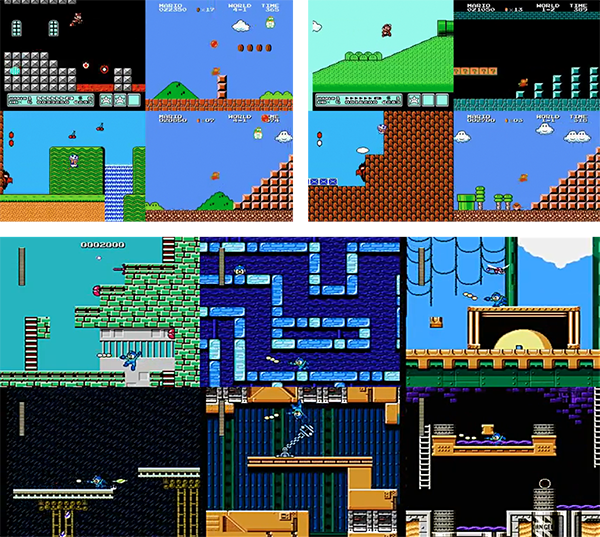
Figure 4.2. A quadrun of four Super Mario Bros. games by agwawaf (top) and a “hexrun” of six Mega Man games by Yashar Nasirian (bottom).
While, from one perspective, multigame TASs are simply an example of virtuosic play, the practice of playing multiple games with a single string of inputs also functions as a critique of videogame seriality. Such playthroughs demonstrate the skill of the player or programmer while exposing the interchangeability between games. As the editors at TASVideos (2007) state, “Baxter and AngerFist prove that Capcom really has been making the same game over and over again by playing Mega Man 3, 4, 5, and 6 using the same input.” The serialization of Mega Man is a product of both corporate franchising and recycled code. For example, the geometry and physics of Mega Man’s basic mechanics—run, jump, and shoot—have not changed in the ten iterations of the classic series built between 1987 and 2010.[17] The game engine shared by the Mega Man games released on the Nintendo Entertainment System as well as the embodied memory required to succeed in challenges tuned to the franchise’s mechanics are dependent on modularity and repetition. And although Mario’s mechanics have certainly morphed over the course of the series, these multigame TAS videos not only showcase machinic precision, but also reveal the serial patterns that migrate from game to game. By expressing the fundamental similarity between these videogames, the tool-assisted speedruns and multigame mashups demonstrate how there is more than a conceptual or aesthetic resemblance: there is also a structural correspondence that exists on the level of platform, engine, and code. Despite the similarities, only a limited number of games have been completed simultaneously. These multigame TAS might evolve, however, to include larger numbers of games and perhaps more disparate types of gameplay. Like the fabled “theory of everything” in popular physics, there could exist input sequences that successfully complete every videogame ever made (and ever will be made) simultaneously.[18]
Still operating within a category of metagames that distribute single input across multiple outputs, numerous mixups and mashups have been programmed that collage and conflate one or more previously discrete videogames. Although these mashups do not explicitly allow players to control many games at once as with multigame TASs or multiboxing MMOs,[19] the recombinations of familiar game mechanics inspire strategies that resemble the cognitive multitasking prompted by DeHackEd, Baxter, Angerfist, and agwawaf’s tool-assisted speedruns. Rather than allowing players to control Pac-Man (1980) and Donkey Kong (1981) at the same time, these metagames make Pac-Man a playable character within Donkey Kong. Mashed-up, mixed-up, and memefied games participate in an aesthetic of sampling that Shaviro (2003, 64) suggests “is the best way, and perhaps the only way for art to come to terms with a world of brand names, corporate logos, and simulacra.” In some instances, corporations have attempted to capitalize on sampling as a marketing gimmick by promoting crossovers between videogame franchises,[20] but within fan communities, amateur programmers produce far more complex forms of recombination that remix not only visual and auditory cues, but metagame mechanics themselves.
Not surprisingly, Mario is one of the most appropriated characters in player-designed mashups. Software such as Grand Unified Game (2002) by Andy Weir,[21] ROM CHECK FAIL (2008) by Jarrad “Farbs” Woods, Tuper Tario Tros. (2009) by French game development studio Swing Swing Submarine,[22] and Mari0 (2012) by Maurice Guégan[23] place Mario within the context of other arcade classics. The premise of ROM CHECK FAIL, for example, is that the read-only memory of a dozen 8-bit videogames has been corrupted, causing a sequence of unpredictable mashups with the graphics, mechanics, and levels of games like Space Invaders (1978) and Asteroids (1979), Defender (1981) and Spy Hunter (1983), Qix (1981) and Pang (1989), as well as The Legend of Zelda (1986) and Super Mario Bros. (see Figure 4.3). Farbs’s game challenges players to micromanage the properties of multiple franchises by preemptively positioning characters not only according to the current recombination present on the screen but also an imagined totality of all the other arcade games. As Play This Thing! editor Patrick Dugan (2011) notes, “You’ll find yourself metagaming, you know that as the Defender jet, you can merc those rainbow cascade things pretty well, but in the process of getting over there, there is a good chance they’ll turn into Goombas, and you’ll get hit. Or maybe you’ll hesitate, as Link, to walk up that hallway, because you could become the Space Invaders turret, unable to move vertically, and get caught by pursuing Gauntlet ghosts.”
More recently, in his carefully constructed Flash game Super Mario Bros. Crossover (2010), Jay Pavlina satisfies the desire to navigate Super Mario Bros. with a wide array of 8-bit videogame protagonists complete with their native graphics, sound effects, and mechanics (see Figure 4.4). In Pavlina’s game the selection of visiting characters includes Samus from Metroid (1986), Bill Rizer from Contra (1987), Ryu Hayabusa from Ninja Gaiden (1988), Sophia the 3rd from Blaster Master (1988), Simon Belmont from Castlevania 2: Simon’s Quest (1990), Bass from Mega Man 10 (2010), Mega Man from Mega Man 4, Link from The Legend of Zelda, Luigi from Super Mario Bros.: The Lost Levels (1986), and, as a default, Mario himself. Selecting Mario simply produces a Flash approximation of the original Super Mario Bros. carefully re-crafted level for level in order to simulate the Mushroom Kingdom—a tabula rasa ready to compare different colors of paint. Considering these crossovers, blogger Henry Gilbert (2011) gushes, “Why stomp a Goomba when you can hit him with a Mega Buster or boomerang? Why break bricks with a jump when you can throw an axe and destroy them all? It all works so well even though it really shouldn’t.” Like Masahiro Sakurai’s design philosophy for both the Kirby and Super Smash Bros. series, explored in chapter 1, Super Mario Bros. Crossover challenges the user to micromanage the mechanics of many diverse franchises, rewarding those players who match the strengths of other games’ protagonists with specific level design in Super Mario Bros.
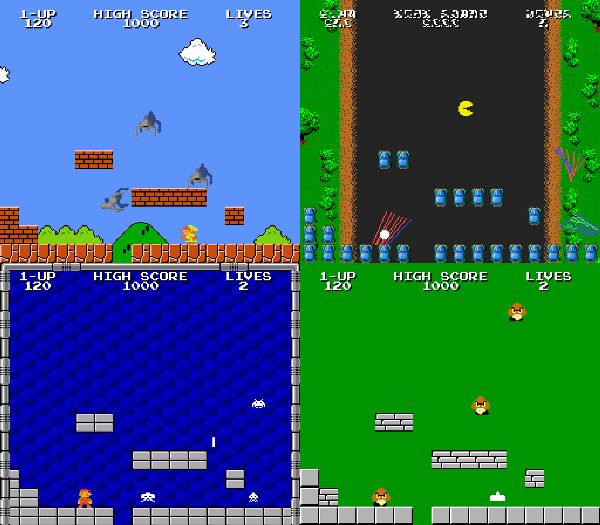
Figure 4.3. Jarrad “Farbs” Wood’s ROM CHECK FAIL mashes up the graphics, mechanics, and music from dozens of 8-bit and 16-bit videogames into a glitchy metagame about games.
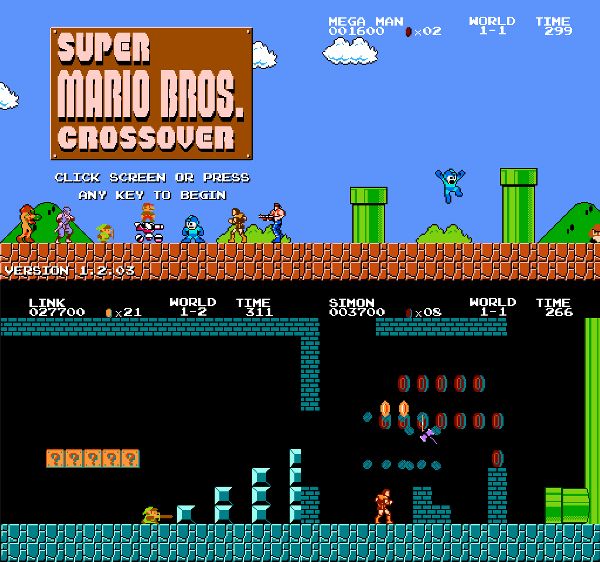
Figure 4.4. The title screen and first levels of Super Mario Bros. feature characters like Mega Man, Link, and Simon Belmont in Super Mario Bros. Crossover by Jay Pavlina.
Whereas Sartre’s seriality corresponds to mechanized forms of repetition and industrial production and Denson and Jahn-Sudmann’s digital seriality articulates the transmedia adaptations, narrative franchises, and level design of videogames, Marc Steinberg proposes yet another concept: new seriality. Steinberg’s (2003, 96) new seriality “corresponds to the information capitalist model,” which “has no origin and proliferates through metamorphosis and translation.” Steinberg adds that this form of new seriality leads to “a mode of consumption which is itself serial: a character is consumed in its many object forms, as pieces of a constantly expanding universe” (2003, 100). Mario’s corporate branding follows this logic of repetition. In the single input, multiple output metagames discussed in this section, Nintendo’s mustachioed mascot is an infinitely renewable resource whose potency lies not in scarcity, but in its multiplication and cross-pollination in numerous projects and media experiments. Integral to this process are not only Mario’s sequels, articulated by agwawaf’s multigames, but also the mashups exemplified by Super Mario Bros. Crossover. The mutations, modulations, and manipulations that occur by placing these series in relation to each other only further activates Mario’s proliferation and brand power.
Multiple Input, Single Output
Rearranging blocks, tempting the player into traps, building impossible architectures, and distributing new games built on old platforms, ROM hacking is the process of changing or altering read-only memory data, a practice usually associated with videogames.[24] Working in conjunction with the debugger, trace loggers, memory watchers, hexadecimal editors, and various viewers now packaged with emulators like FCEUX, this community metagame can take the form of researching how games work, building ROM and RAM maps, hacking hex data, or even writing new assembly routines into old videogames—a difficult process that must account for the material platforms and programming idioms of past forms of play. As the central community hub at ROMhacking.net (2005) puts it,
Comprising both the analysis and manipulation of data, hacking can appeal to the spirit of exploration, creative problem solving, engineering, and creativity. Thanks to the subject’s breadth and its propagation through the Internet, ROM hacking has become an art form of sorts.
Like the tool-assisted speedrunning discussed in the last section, ROM hacking is made possible by the extended functionality of videogame emulators and, as a practice, enables new forms of play operating in the idiom of game design and leveraging the data from games like Super Mario Bros.
In his press kit for ROM CHECK FAIL, Farbs (2008) notes that the seven avatars, seven enemies, seven chipsets, thirty-four audio tracks, thirty-one end screens are an “authentic re-implementation” of arcade and home console classics. What kind of reverse engineering and reconstruction is necessary to simulate Super Mario Bros., a game so intensely wed to the affordances and constraints of its technical platform? It’s immediately clear from the open source Python code Farbs released as ROM CHECK YOURSELF (2011)[25] that ROM CHECK FAIL simulates the graphics and mechanics of Super Mario Bros. but aside from these resemblances is in no way the same as Nintendo’s game. On the other hand, ROM hacks like ATA’s Mario vs. Airman (2008) attempt to more directly combine Super Mario Bros. code and assets with other well-known NES-era titles. Based on (and including a chiptunes remake) of a Japanese dōjin video called Air Man ga Taosenai or Can’t Beat Air Man (2007),[26] in Mario vs. Airman the player guides Mario or Luigi, complete with the familiar control scheme and jump physics of Super Mario Bros., to navigate Air Man’s famous level from Mega Man 2. After hosting a download of the game on her blog, anna anthropy (2008) argues, “Mashups like this illuminate design trends between games. Mario and megaman [sic] share ‘jump’ as a primary verb, which is why it’s possible to complete this hack at all.” Another example is Bennett Foddy and AP Thompson’s Multibowl (2016), a gamified combination of both the MAME and MESS emulators that boot up save states and subsequently track scores over 230 arcade and console games. The result: a kaleidoscopic sampling of competitive, two-player action from the expanded history of videogames. Through careful curation and custom emulation, Multibowl imagines every videogame as a minigame within its WarioWare-like metaverse.
Mashups like Mario vs. Airman and Multibowl are not the only metagames made possible by ROM hacking. From Mario’s many worlds to Mario artificial intelligences to Mario crowd simulations, the design philosophies that evolve alongside the increased functionalities of emulators like FCEUX lead to game designs that assume players will use slow motion and save states to complete even the most complex challenges by grinding each serial instant over and over. Discussed in chapter 1, the result of this ROM hacking metagame is the emergence of a whole genre of intensely difficult games that Douglas Wilson and Miguel Sicart (2010, 40) call “abusive games.” From tool-assisted input patterns designed to play multiple games simultaneously to mechanics mashups programmed to mix and match multiple titles, tenacious players have found ways to explore the seriality of both videogame sequels and videogame platforms through multigame metagaming of quadruns and mashups. But considering ROM hacks are designed to be played over and over with tools, how do multiple inputs produce a single output?
In a Popular Science article titled “The Super Mario Multiverse,” Abby Seiff (2011) gives a lesson in basic quantum theory using a video created with Andi McClure’s[27] Many Worlds Emulator in which “134 overlaid playthroughs represent the manifold possibilities Mario encounters as he progresses through his world.” The Many Worlds Emulator was published in response to video documentation of players attempting to complete the unreasonably difficult Kaizo Mario World, which roughly translates to Hack Mario World. According to McClure (2008), “Kaizo Mario World is one of a series of ROM hacks people created in special level editors that let you take Super Mario World and rearrange all the blocks; the point of Kaizo appears to have been to create the most evil Super Mario World hack ever” (emphasis original). Given the absurd difficulty of this particular ROM hack, affectionately referred to as “Asshole Mario,” most playthroughs of Kaizo Mario World rely on an emulator’s ability to save and load game states in order to redo a single section until it is properly executed.[28] In order to complete the game each second must be replayed over and over “Steve Reich style” (McClure 2008).
To make the Many Worlds Emulator, McClure adapted the SNES9X emulator to composite the replays rather than erase them when the player rewinds. As opposed to a flawless playthrough with all of the failed attempts scrubbed out, her emulator incorporates these blunders into a final video render (see Figure 4.5). As McClure writes, “what makes Kaizo great is watching someone fail over and over and over again until they finally get it right.” Since the release of Super Mario Maker (2015) for Wii U, a game through which Nintendo attempts to enclose the ROM hacking practices that birthed Kaizo Mario, these near impossible level designs that test player’s patience and skill as well as their physical and mental health have transformed from a niche practice to a thriving scene. Clearly, there is a masochistic audience for these sadistic level designs as perverse hacks become a spectator sport in which hundreds of Marios fall in pits, run into spikes, and get stomped by Goombas.
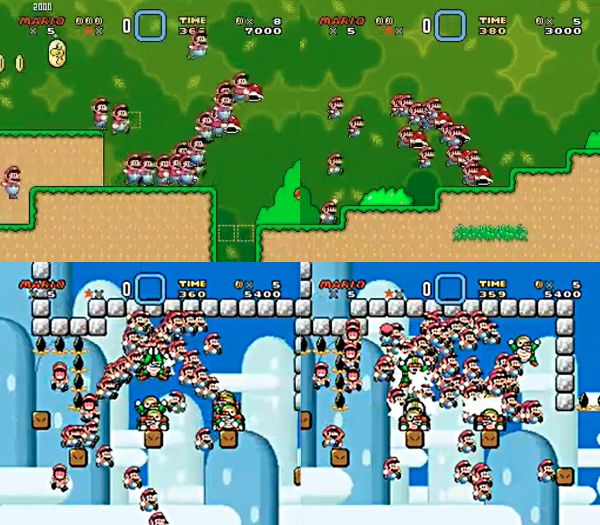
Figure 4.5. Andi McClure’s Many Worlds Emulator visualizes multiple playthroughs of Super Mario World (top) and the Kaizo Mario World ROM hack (bottom).
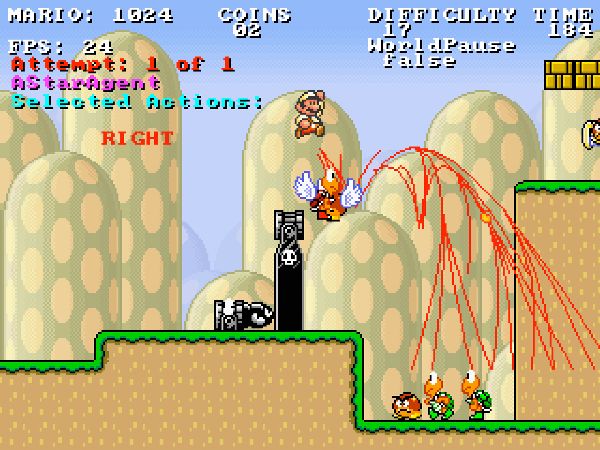
Figure 4.6. Red vectors are traced from Mario to every possible position in Robin Baumgarten’s winning entry from the Mario AI Competition in 2009.
Another manifestation of quantum Mario appears in Sergey Karakovskiy and Julian Togelius’ Mario AI competitions, hosted annually at various computer science conferences including EvoStar, World Congress on Computational Intelligence (WCCI), and the Institute of Electrical and Electronics Engineers Conference on Computational Intelligence in Games (IEEE-CIG). Using Notch’s Infinite Mario Bros. (2006), a Java application that procedurally generates random levels based on the gameplay mechanics of Super Mario Bros. 3 with the sprite-based graphics of Super Mario World, Karakovskiy and Togelius invited ROM hackers and AI researchers alike to compete by programming Mario to traverse Persson’s infinite terrain.[29] In 2009, Robin Baumgarten[30] achieved minor celebrity with his elegant solution based on the A* Algorithm, a pathfinding heuristic using the best-first search.[31] Alongside a zipping, seemingly infallible Mario, Baumgarten’s algorithm renders webs of red pixel vectors—tendrilized feelers shooting out in front of the plumber, cataloging every possible path from second to second (see Figure 4.6).
Finally, the massive artificial intelligence or mass AI is a common player-produced rendering technique that collects the individual performances of human players or automated bots and overlays or composites them into one game environment. Rather than suggest the invariant singularity of digital data, videos produced with games like Team Fortress 2 (2007) and Trackmania (2003) use mass AI to create crowds of thousands of bots executing a multitude of actions in-game to reveal the geometric limits of level design through the physics of automated avatars. Like Maurice Guégan’s visualizations of a thousand Marios cascading through a custom Mari0 level at Gamescon in 2015, these crowd simulations range from the surreal layering of hundreds of moving images, to domino-like chain events, to granular fluid dynamics (see Figure 4.7). By collaging thousands of mechanically mediated playthroughs, rendering experiments like mass AI or crowd simulations implicitly invoke the serial conditions under which all games are played. The once-anomistic, individualized activities are collectively visualized.
Instead of executing the game in a discrete, sequential order, these three examples convert the player’s labor (be they human or nonhuman) into a visual cacophony as hundreds of Marios simultaneously follow all possible paths as they traverse a level. McClure sees this “Mario cloud” as an emblem for the multiplicity of potential action suggested by the many-worlds interpretation of quantum mechanics. In the Many Worlds Emulator, the struggles of one hundred playthroughs are collaged within the same frame. These renderings produce a cubist-like overlaying of temporalities as the real and the possible converge and invite the player to imagine how their own actions fit into a pattern of wave–particle duality—their individual choices represented as both unique events and part of a larger system of relations. Whereas Sartrean seriality describes the relationship of individuals to groups, this pop-physics example of the many-worlds interpretation frames a self in relationship not to other selves, but to a cloud of all possible, parallel versions of selves.
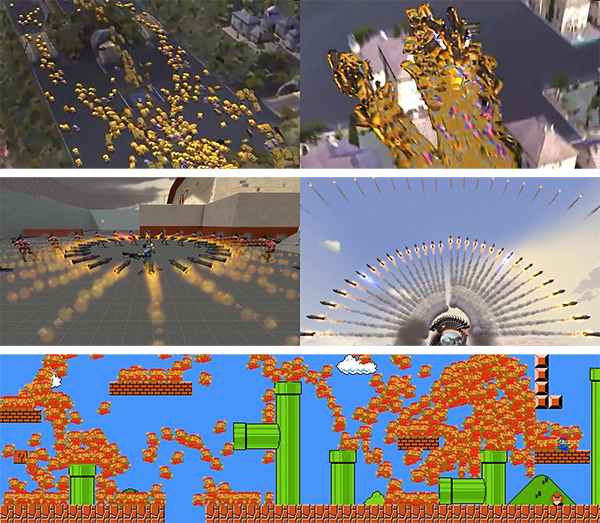
Figure 4.7. Mass AI resembles fluid dynamics in Blackshark and Amraphent’s “The 1K Project II,” made in Trackmania (top) and reveals geometric patterns in the USK Clan’s “USK Mass Bots,” made with Team Fortress 2 (middle) whereas a thousand human players pilot Mario through Maurice Guégan’s custom Mari0 level (bottom).
The seriality of a player’s performance, both imaginary and actual, has also been incorporated into new forms of gameplay that posit button presses as probabilities within a much larger set of aggregate actions. For example, an emerging genre of self-cooperative gameplay involves recording a player’s actions for a limited time and then simulates a multiplayer environment by replaying the combined actions of a limited number of previous playthroughs. These multiple recordings—or past lives—do not function simply as ghosts visualizing past plays but perform realtime actions necessary for further exploration of the game (e.g., holding a door open for future navigation). Self-cooperative gameplay was popularized by Yoshio Ishii’s Cursor*10 from Nekogames and has proliferated in other Flash applications like A Good Hunch (2007–8), Timebot (2007), and Chronotron (2008), as well as in games for more advanced platforms including Braid (2008), Onore no Shinzuru Michi wo Yuke (2009), Time Donkey (2009), Ratchet and Clank: A Crack in Time (2009), The Misadventures of P. B. Winterbottom (2010), Super Time Force (2014), and Echoshift (2009)—a sequel to the Echo series discussed in chapter 2. Alternatively, this mechanic is sometimes used self-competitively rather than self-cooperatively, as seen in The Road Less Taken (2007) and DefeatMe (2009).[32] While many videogames require multiple playthroughs either as punishment for mistakes or to elongate playtime, in self-cooperative games both graphic and ludic layering rely on cumulative results that arise from the interactions between prerecorded playthroughs as space and time are layered with multiple inputs but only a single output. While playing within a crowd of past actions and producing new input with future outcomes in mind, players must navigate the strange effects of their own stacked and serialized aggregations.
Incorporating Metagames
Since at least the release of the Nintendo Entertainment System in 1985, Nintendo has been notably cautious when it comes to protecting their proprietary technologies, intellectual properties, and global brand. Starting with the star-shaped security screws holding together cartridges, the NES10 lockout chips that attempt to verify only licensed software, and even the gold Official Seal of Quality marking the company’s curated games, Nintendo hoped to carefully control their corporate console and avoid the fate that befell Atari’s considerably more open platform during the North American videogame crash of 1983 (signified by the E.T. the Extra-Terrestrial [1982] cartridges dumped in Alamogordo, New Mexico, mentioned in chapter 2). These early forms of digital rights management both camouflage the serial structures of the standard metagame and inspire the multigamic, mashed-up, many-worlded, and mass metagames discussed throughout this chapter (as well as a few ingenious piracy techniques).[33] However, when indie games, digital storefronts, persistent user names, and online chats transform videogames from platforms for private play to social networks in the twenty-first century, apparently Nintendo’s closed systems leave something to be desired.
In an effort to expand their corporate control beyond individual instances of domestic play, Nintendo has begun to recapture and capitalize on those games occurring in, on, around, and through Super Mario. For the first time, at the Electronic Entertainment Expo (E3) in 2014, Nintendo invited players to compete with one another on stage at the Super Smash Brothers Wii U Invitational Tournament. Whereas Sakurai added luck-based mechanics to Super Smash Bros. Brawl (2008) in order to explicitly stymie the competitive metagame, Super Smash Bros. Wii U (2014) seemed open to the possibility of competitive play that culminated in the grand finals between Gonzalo “ZeRo” Barrios and Juan “Hungrybox” Debiedma (the latter of whom, coincidentally, was piloting Sakurai’s favorite pink puffball, Kirby). Then, at E3 in 2015, Nintendo held Ultimate NES Remix (2014) competitions in eight locations across the United States before flying the eight winners alongside eight invited players to the L.A. Convention Center to compete in the Nintendo World Championships. After playing through a number of minigames reminiscent of the original Nintendo World Championships in 1990, the grand finals featured none other than Narcissa Wright facing off against John Goldberg (AKA John Numbers) in Nintendo’s new Super Mario Maker (2015)—a Mario Paint–like program for designing, testing, sharing, and playing custom levels created from the assets and mechanics featured across Nintendo’s entire Mario franchise.[34] Beyond their late entry into hosting competitive tournaments Nintendo worked to absorb and appropriate many forms of metagaming back into the Mario series itself culminating in videogames like Super Mario Maker.
From smashing and speedrunning to multigames, mash-ups, many-worlds, and mass AI, in the 2010s Nintendo is starting to expropriate the Mario metagames played with emulators since the early 2000s (see Figure 4.8). For example, redeploying the cherries that first appeared as bonus items in Super Mario Bros. 2, the “Double Cherry” power-up first featured in Super Mario 3D World (2013) and then again in its spinoff, Captain Toad Treasure Tracker (2014), multiplies the number of player-controlled characters jogging around seafoam cliffs, pink hills, and bolted boxes of Double Cherry Pass. Directed by a single set of controller input, groups of two, three, four, or five Marios, Luigis, Princesses, and Toads articulate the parallel processes of videogames and operate according to the same logic as the quadruns, hexruns, and nonruns considered at the beginning of this chapter. Apparently, whether it’s Baxter, DeHackEd, AngerFist, and agwawaf’s multigame tool-assisted speedrun or the Double Cherry, playing many games with one controller is no longer outside Nintendo’s gloved grip.
Beyond the way the Super Smash Bros. series remixes Nintendo’s popular franchises and corporate branding, games like NES Remix (2013) and NES Remix 2 (2014) explicitly recombine discrete pieces of old software into new forms of gameplay. Unlike Farbs’s ROM CHECK FAIL and Jay Pavlina’s Super Mario Crossover and following the strategies of ROM hacks like ATA’s Mario vs. Airman and gamified frameworks like Bennett Foddy and AP Thompson’s Multibowl, NES Remix begins with emulation. Building metagames around the instruction sets and algorithmic processes of original Nintendo ROMs, NES Remix cleverly isolates and re-presents critical moments of games such as Super Mario Bros., The Legend of Zelda, Donkey Kong, Metroid, and Kirby (among twenty-three others). These short tutorials evolve from simply loading a game state and tracking player progress to more complex ROM hacked recombinations: Mario as a single-switch infinite runner where only the A button matters, Samus from Metroid breaking blocks in the sewers of the Mushroom Kingdom, a swordless Link climbing ladders to avoid barrels in Donkey Kong, and ghastly Boos from Mario chasing down Kirby in the Whispy Woods. As Nathan Altice (2014, 330) argues in the conclusion of I AM ERROR, “Nintendo is not simply re-presenting their own legacy, but directly competing with the emulation ecosystem that has thrived for decades, generating their own Famicom hacks and remixes. Nintendo is redefining its platform in its own emulated image.”
Beyond the duplicities of the Double Cherry and the mashups of NES Remix, some of Nintendo’s software shows a different form of seriality: the replays and recordings left behind when we play videogames. Following instances of enemy AI that simply mirrors player movement such as the rat-like Goriya in The Legend of Zelda: Link to the Past (1991) or the Mario double in the Sunken Ship of Super Mario RPG: Legend of the Seven Stars (1996), in Super Mario Galaxy 2 (2009) and Super Mario 3D World, Mario’s in-game actions are sometimes replicated by “Cosmic Clones” that proliferate endlessly and force the player to navigate the level while avoiding an array of temporally delayed doppelgängers trailing behind. Across the galaxies, hoards of maroon Marios propagate along paths originally pioneered by the player, becoming a record of past play as well as obstacle to overcome. Like Andi McClure’s Many Worlds Emulator or the self-cooperative and self-competitive games explored earlier, the recording and playback in Nintendo’s games historicize play itself as their games mark, if only fleetingly, traces of player movement.
Although the mirror movements of Nintendo’s simple AIs are not as complex as Robin Baumgarten’s all-knowing Mario, automation has become central to Nintendo’s game design—especially in the case of modulating difficulty and teaching players through bots. Starting in both New Super Mario Bros. Wii (2009) and Super Mario Galaxy 2 (2009), the company has included a “Super Guide” in the form of an automatic Luigi who can run through levels without player intervention. If the player fails enough times on any given level, an option appears to activate the Super Guide after which Luigi will expertly work his way through the bothersome level. Like a tool-assisted speedrun or Baumgarten’s Mario AI, Luigi dances across the digital landscape, ducking and dodging enemies while both teaching the player new tricks and furthering his or her progress throughout the game. However, rather than generating every possible path, the Super Guide operates more like a demo in which Nintendo’s employees have recorded specific instances of pedagogical play reminiscent of the looping attract screens of arcade games and the original Super Mario Bros.[35]
It is no coincidence that many of the metagames discussed in this chapter are conflated in Nintendo’s Super Mario Maker (see Figure 4.9). From the rotating characters and tilesets of Mario mashups to playthroughs of multiple Mario games at once and from the community practices of ROM hacking to the time trials of realtime attacks, Super Mario Maker is the company’s attempt to incorporate the metagame. The game allows players to build and share levels, but only to other players who have the game and only through Nintendo’s network. Beyond the limitations of the interface, there is no way to alter the source code, archive level data, or burn the game onto original hardware. This incorporation is perhaps best indicated by the cease and desist letters designed to funnel those player practices produced on open platforms back into Nintendo’s corporate ecosystem. Sent to YouTube channels from the Nintendo Anti-Piracy Team in the days and weeks preceding the release of Super Mario Maker, the company states in no uncertain terms “please note that this Code of Conduct prohibits you, among other things, from posting any content using unauthorized software or copies of games. This includes videos featuring tool-assisted speedruns, which require making a copy of a game’s ROM file, and running the copied ROM through an emulator” (Hernandez 2015). So Super Mario Maker both attempts to enclose metagaming while simultaneously disenfranchising metagamers.
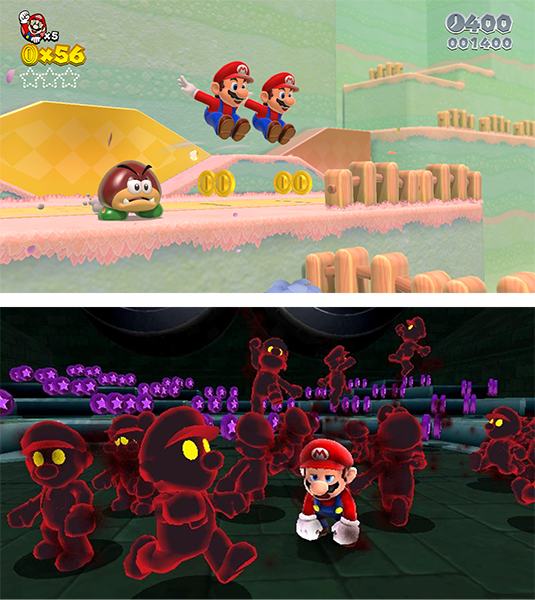
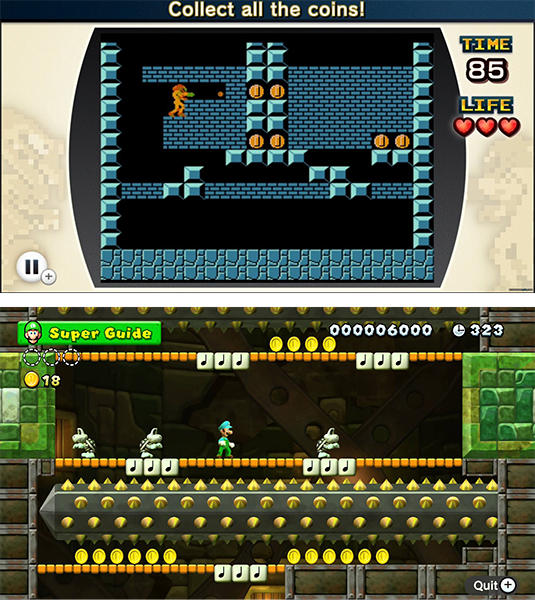
Figure 4.8. In Nintendo’s Super Mario 3D World (top left), NES Remix (top right), Super Mario Galaxy 2 (bottom left), and New Super Mario Bros. Wii (bottom right), previously ignored metagaming practices are incorporated into the Super Mario series.
The following chapter tracks this behavior in the context of the modding communities and pro gamers that made Defense of the Ancients (2003–) and Valve, a company that extends these forms of incorporation by building a business plan based on colonizing (rather than policing) the metagame. Whereas Nintendo has been reluctant to expand its platform into online marketplaces, downloadable content, cosmetic markets, competitive gaming, live streaming, and modding, Valve has embraced this as their core game design (and managerial) philosophy. And while the time represented by videogames as the ideological avatar of play is often coded as off the clock, outside of work, or a waste of time, suddenly all that time spent playing serial games like Super Mario Bros. does not seem nearly as ineffable. A hundred thousand billion fingers, and a hundred thousand billion years of working with our hands, have ultimately emerged as a valuable commodity as play becomes a form of production.
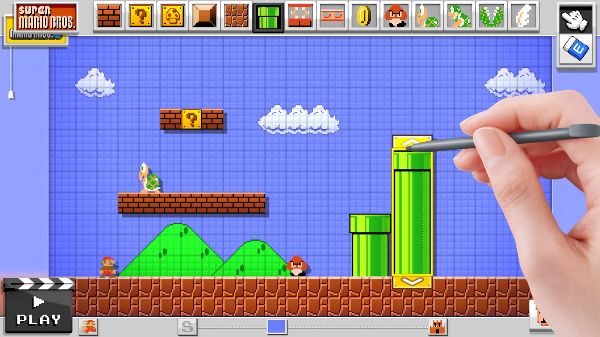
Figure 4.9. In some ways, Super Mario Maker encapsulates Nintendo’s strategy to enclose the work of ROM hackers, speedrunners, and other metagamers by building corporate platforms for what was, historically, community labor.
Hundred Thousand Billion Years
How much time do we play? How much play do we time? Serial games encourage the partitioning of smooth durations into individuated units of empty homogenous time—exchangeable, measurable time. Jane McGonigal’s Reality is Broken: Why Games Make Us Better and How They Can Change the World (2011) begins with a manifesto-like celebration of the serial effects of networked culture. In a frequently cited passage of the book, McGonigal (2011, 52) claims that “if you add up all the hours that gamers across the globe have spent playing World of Warcraft since the massively multiplayer online (MMO) roleplaying game (RPG) first launched in 2004, you get a grand total of just over 50 billion collective hours—or 5.93 million years.” Although these numbers may be awe inspiring—there are no doubt hundreds of thousands of millions of hours invested in gaming platforms like World of Warcraft—the rhetorical potency of McGonigal’s figures relies on a misrepresentation of seriality. Why characterize years of collective action involving millions of players as a singular, linear duration instead of, for example, a rate like twenty hours a week per player? When compared to the finite life of the reader, McGonigal’s 5.93 million years appear sublime and beyond measure, but relative to the serial processes of collective life, the statistic falls flat. Using the same logic McGonigal applies to World of Warcraft, one could say that the 7 billion people on Earth collectively live 19 million years every day (and that is certainly not counting for those automatic or automated forms of labor and leisure).
Further compounding this confusion, McGonigal proposes a homology between time spent playing World of Warcraft and the process of human evolution. “5.93 million years ago is almost exactly the moment in history that our earliest human ancestors first stood upright,” she writes, and “by that measure, we’ve spent as much time playing World of Warcraft as we’ve spent evolving as a species” (2011, 52). In order to demonstrate the power of network phenomena and render these operations legible, McGonigal treats human evolution as an unbroken and linear flow of time and translates the synchronic actions of the multitude onto a diachronic timescale. But evolution is not a single-player game. If one were to make an equivalency comparing the total playing time in World of Warcraft to the total time humans have spent living on Earth, McGonigal’s original 5.93-million-year timeline would have to be multiplied by the average size of the human population at each instant of that timeline, producing a number that far exceeds all but a mathematical understanding of scale.
There is another assumption implicit in McGonigal’s suggestion that somehow “evolving” from level one to eighty-five is co-terminous with the progress from bipedalism to the present. Her analogy is underwritten by a fixed concept of “the human” and the assumption that agency is the dominant contributing factor in the evolution of a species. But there is no singular, unbroken lineage that can be traced back to the Paleolithic Period. Evolution is the product of a complex interweaving of genetic and environmental factors (including the playing of World of Warcraft) that contribute not to the flow of species, but to what Manuel DeLanda (1997, 259) might describe as a serial “flow of biomass through foodwebs as well as the flow of genes through generations” over a thousand years of nonlinear history. The desire for a monolithic and totalizing metaphor for network activity is constantly thwarted by the units within the network model itself—the combinations of mechanical, electrical, and computational processes that can never be fully reduced to the time-space of an individual human subject. This bitwise approach is echoed by Ian Bogost (2006, 8) when he writes in Unit Operations, “The Internet, the brain, human genetics, and social fads are examples of complex, unit-driven networks.”
In “Cybernetics and Ghosts,” Italo Calvino (1986, 8–9) notes the similarities among Hundred Thousand Billion Poems, the game of chess, and the “electronic brain”: “Just as no chess player will ever live long enough to exhaust all the combinations of possible moves for the thirty-two pieces on the chessboard, so we know (given the fact that our minds are chessboards with hundreds of billions of pieces) that not even in a lifetime lasting as long as the universe would one ever manage to make all possible plays.” Encountering every poetic, programmatic, or neural combination is impossible, and yet it is exactly those hidden patterns and unconscious repetitions that serial games explore. Thus, like readers, computer game enthusiasts engage in vast networks of patterns that make up the aggregate histories of virtual worlds. But rather than remaining subject to the mechanisms of control as defined by the rules of the game, the Mario modifications, alternative practices, and digital histories explored in this chapter successfully metagame the serial constructs players are working within and against to model the movements of a hundred thousand billion fingers.
We use cookies to analyze our traffic. Please decide if you are willing to accept cookies from our website. You can change this setting anytime in Privacy Settings.